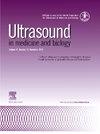手持式即时超声定量肝脂肪评估:成人技术实施和试点研究。
IF 2.4
3区 医学
Q2 ACOUSTICS
引用次数: 0
摘要
目的:研究手持式即时超声(POCUS)定量超声(QUS)用于成人肝脏脂肪评估的可行性,并对其性能进行评价。材料和方法:这项前瞻性的irb批准,符合hipaa标准的试点研究招募了超重或肥胖的成年人。参与者接受了化学位移编码磁共振成像,以估计质子密度脂肪分数(PDFF),并在1个月内由专家超声医师和新手操作员(没有之前的美国扫描经验)使用POCUS设备进行QUS。使用POCUS设备收集的肝脏射频数据进行离线分析,使用探针特定校准来估计两个QUS参数:衰减系数(AC)和后向散射系数(BSC)。估计每个参数的受试者工作特征曲线下面积(AUC),用于分类肝脂肪变性的存在/不存在(定义为PDFF≥5%)。估计各参数与PDFF之间的Spearman秩相关并评估其显著性。结果:18名参与者(平均年龄43岁±14岁;17例女性),8例肝脂肪变性(PDFF≥5%)。AC和BSC对肝脂肪变性的诊断准确率分别为0.96 ~ 0.97、0.88 ~ 0.89 (p均< 0.01),与PDFF的相关系数分别为0.65 ~ 0.69、0.58 ~ 0.65 (p均< 0.02)。结论:QUS可以在POCUS设备上实施,可以由专家或新手操作员在有限的培训后对超重或肥胖的成年人进行,初步效果良好。本文章由计算机程序翻译,如有差异,请以英文原文为准。
Quantitative Liver Fat Assessment by Handheld Point-of-Care Ultrasound: A Technical Implementation and Pilot Study in Adults
Objectives
To implement, examine the feasibility of, and evaluate the performance of quantitative ultrasound (QUS) with a handheld point-of-care US (POCUS) device for assessing liver fat in adults.
Materials and Methods
This prospective IRB-approved, HIPAA-compliant pilot study enrolled adults with overweight or obesity. Participants underwent chemical-shift-encoded magnetic resonance imaging to estimate proton density fat fraction (PDFF) and, within 1 mo, QUS with a POCUS device by expert sonographers and novice operators (no prior US scanning experience). Radiofrequency data from the liver collected with the POCUS device were analyzed offline using probe-specific calibrations to estimate two QUS parameters: attenuation coefficient (AC) and backscatter coefficient (BSC). Area under the receiver operating characteristic curve (AUC) of each parameter was estimated for classifying presence/absence of hepatic steatosis (defined as PDFF ≥ 5%). Spearman rank correlation between each parameter and PDFF was estimated and its significance assessed.
Results
Of 18 participants (mean age, 43 y ± 14; 17 women), 8 had hepatic steatosis (PDFF ≥ 5%). Both AC and BSC classified hepatic steatosis accurately with AUCs of 0.96–0.97 for expert and 0.88–0.89 for novice operators (p < 0.01 for all) and correlated significantly with PDFF with rho's of 0.65–0.69 for expert and 0.58–0.65 for novice operators (p < 0.02 for all).
Conclusion
QUS can be implemented on a POCUS device and can be performed by expert or novice operators after limited training in adults with overweight or obesity with promising initial results.
求助全文
通过发布文献求助,成功后即可免费获取论文全文。
去求助
来源期刊
CiteScore
6.20
自引率
6.90%
发文量
325
审稿时长
70 days
期刊介绍:
Ultrasound in Medicine and Biology is the official journal of the World Federation for Ultrasound in Medicine and Biology. The journal publishes original contributions that demonstrate a novel application of an existing ultrasound technology in clinical diagnostic, interventional and therapeutic applications, new and improved clinical techniques, the physics, engineering and technology of ultrasound in medicine and biology, and the interactions between ultrasound and biological systems, including bioeffects. Papers that simply utilize standard diagnostic ultrasound as a measuring tool will be considered out of scope. Extended critical reviews of subjects of contemporary interest in the field are also published, in addition to occasional editorial articles, clinical and technical notes, book reviews, letters to the editor and a calendar of forthcoming meetings. It is the aim of the journal fully to meet the information and publication requirements of the clinicians, scientists, engineers and other professionals who constitute the biomedical ultrasonic community.

 求助内容:
求助内容: 应助结果提醒方式:
应助结果提醒方式:


